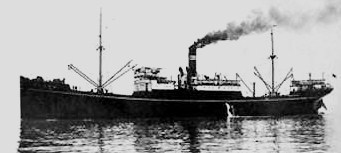RIKUGUN YUSOSEN
 (SURABAYA MARU, prewar)
(SURABAYA MARU, prewar)
SURABAYA MARU:
Tabular Record of Movement
© 2014 Bob Hackett
1918:
Sakurajima. Laid down at Osaka Iron Works as a 4,391-ton
passenger-cargo ship for the Osaka Shosen Kaisha (OSK) Line, Kobe.
November 1918:
Launched and named SURABAYA MARU.
30 December 1918:
Completed. She can accommodate 12 first class and 58
third class passengers and carries a crew of 55.
1919-1937:
Placed in service on OSK’s Kobe ~ Formosa ~ Manila ~
Borneo route.
7 July 1937: The Marco Polo Bridge Incident ("First China Incident"):
Hun River, Lukuokiao, China. Imperial Japanese Army (IJA) troops on night maneuvers at the Marco Polo Bridge fire blank cartridges. Chinese troops across
the river think they are under attack. They fire live rounds back, but do not cause injuries. At morning roll call, the Japanese discover a soldier missing and assume the Chinese have captured him. The Japanese demand entry to the Peiping (Beijing) suburb of Wanping to look for the soldier, but the Chinese refuse. The Japanese then shell the city. An undeclared war on China begins.
1937:
Chartered by the IJA as a troop transport.
1937~ 1942: Sino-Japanese War:
Carries troops between Japan and Chinese ports.
12 October 1941:
Requisitioned by the IJA as a troop transport. Allotted Army No. 115.
25 May 1942:
SURABAYA MARU departs Karatsu Bay, N Kyushu for Shanghai in a convoy also consisting of NANKING, ROKKO, YURI, KOKI and UJINA MARUs
escorted by auxiliary gunboat TOMITSU MARU. The convoy is carrying 6,600 men of the IJA 70th Infantry Division.
28 May 1942:
At 1519, arrives at Shanghai. Disembarks troops.
30 July 1942:
SURABAYA MARU departs Imari Bay, Japan for Shanghai in an unidentified convoy also consisting of KANKYO, MITO, PACIFIC and ROKKO MARUs
escorted by minelayers TSUBAME and KAMOME and auxiliary minelayer KAHOKU MARU.
1 August 1942:
At 1745, arrives at Woosung. Soon after, enters the Whangpo River to Shanghai.
21 December 1942: No. 6 Go Transportation Operation:
Convoy No. 35 assembles at Shanghai to transport the IJA’s 6th Infantry Division via Truk to
Guadalcanal (after the decision to evacuate Guadalcanal is made, the convoy’s destination is changed to New Guinea).
The convoy consists of troop convoy Parts A, B and C. Part C consists of SURABAYA, MEIU, SOMEDOMO and SHINAI MARUs. Part A and Part B depart Shanghai for
New Guinea.
25 December 1942:
SURABAYA MARU departs Shanghai in Part C escorted by destroyer TSUGA.
19 January 1943:
Part C departs Truk for Shortlands, Bougainville.
20 January 1943:
286 miles from Truk. LtCdr (later Rear Admiral-Ret) Creed C. Burlingame’s USS SILVERSIDES (SS-236) attacks the convoy. At 1755,
SILVERSIDES fires six torpedoes at three ships in Part C. Burlingame hits MEIU MARU and damages heavily SURABAYA MARU at 03-24N, 153-31E. [1]
At about 1915, MEIU MARU sinks. She was carrying a battalion of the IJA 6th Infantry Division’s 23rd Regiment, a crew of about 100 men and 70 gunners
plus 40 horses. About 400 soldiers are KIA and one crewman.
SURABAYA MARU is hit portside forward. She takes on a list and begins to sink by the stern. She is carrying 1,120 men of the 6th Infantry Division, a
medical unit and others, a crew of 72 men and 35 gunners. 462 soldiers are KIA and Captain Kobayashi and 36 other crewmen.
Subchaser CH-11 and gunboat CHOAN MARU No. 2 rescue survivors. Later, destroyer ASAGUMO arrives from Truk and scuttles SURABAYA MARU.
Author's Notes:
[1] SILVERSIDES probably also sank Part C’s SOMEDOMO MARU (5,154 t) during this engagement, but some sources say she was sunk by aircraft at a different time and place.
Thanks goes to Erich Muehlthaler of Germany.
Bob Hackett
Back to IJA
Transports





